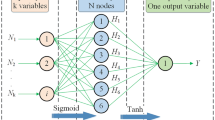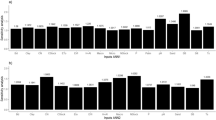Abstract
Artificial intelligence methods are employed to predict cation exchange capacity (CEC) from five different soil index properties, namely specific surface area (SSA), liquid limit, plasticity index, activity (ACT), and clay fraction (CF). Artificial neural networks (ANNs) analyses were first employed to determine the most related index parameters with cation exchange capacity. For this purpose, 40 datasets were employed to train the network and 10 datasets were used to test it. The ANN analyses were conducted with 15 different input vector combinations using same datasets. As a result of this investigation, the ANN analyses revealed that SSA and ACT are the most effective parameters on the CEC. Next, based upon these most effective input parameters, the fuzzy logic (FL) model was developed for the CEC. In the developed FL model, triangular membership functions were employed for both the input (SSA and ACT) variables and the output variable (CEC). A total of nine Mamdani fuzzy rules were deduced from the datasets, used for the training of the ANN model. Minimization (min) inferencing, maximum (max) composition, and centroid defuzzification methods are employed for the constructed FL model. The developed FL model was then tested against the remaining datasets, which were also used for testing the ANN model. The prediction results are satisfactory with a determination coefficient, R 2 = 0.94 and mean absolute error, (MAE) = 7.1.







Similar content being viewed by others
References
Akbarzadeh A, Mehrjardi RT, Lake HR, Ramezanpour H (2009) Application of artificial intelligence in modeling of soil properties (case study: roodbar Region, North of Iran). Env Res 3(2):19–24
Amini M, Abbaspour KC, Khademi H, Fathianpour N, Afyuni M, Schulin R (2005) Neural network models to predict cation exchange capacity in arid regions of Iran. European J of Soil Sci 56:551–559
ASCE Task Committee (2000) Artificial neural networks in Hydrology. I: preliminary concepts. J Hydrol Eng 5(2):115–123
ASTM (1999) American Society of Testing Materials, Annual book of the ASTM standards. ASTM International, 04-08, West Conshohocken
Cerato AB (2001) Influence of specific surface area on geotechnical characteristics of fine-grained soils. MSc. Thesis, Massachusetts University, Amherst, USA
Chapman HD (1965) Cation exchange capacity. In: Black JA (ed) Methods of soil analysis. Agronomy, vol 9. American Institution of Agronomy, Madison, pp 891–901
Cihacek LJ, Bremner JM (1979) A simplified ethylene glycol monoethyl ether procedure for assessment of soil surface area. Soil Sci Soc Am J 43:821–822
Curtin D, Smillie GW (1976) Estimation of components of soil cation exchange capacity from measurements of specific surface and organic matter. Soil Sci Soc Am J 40:461–462
Farrar DM, Coleman J (1967) The correlation of surface area with other properties of nineteen British clay soils. J Soil Sci 18(1):118–124
Fooladmand HR (2008) Estimating cation exchange capacity using soil textural data and soil organic matter content: a Case Study for the South of Iran. Archi Agro Soil Sci 54(4):381–386
Govindaraju RS, Rao AR (2000) Artificial neural networks in Hydrology. Water science and technology library, vol 36. Kluwer, Dordrecht
Jantzen J (1999). Design of fuzzy controllers, Technical Report, No:98-E864, Department of Automation,Technical University of Denmark
Keshavarzi A, Sarmadian F (2010) Comparison of artificial neural network and multivariate regression methods in prediction of soil cation exchange capacity. World Acad Sci Engand Tech 72:495–500
Keshavarzi A, Sarmadian F, Labbafi F, Vandechali MR (2011) Modeling of soil cation exchange capacity based on fuzzy table look-up scheme and artificial neural network approach. Modern Appl Sci 5(1):153–164
Manrique LA, Jones CA, Dyke PT (1991) Predicting cation exchange capacity from soil physical and chemical properties. Soil Sci Soc Am J55:787–794
Ohtsubo M, Takayama M, Egashira K (1983) Relationships of consistency limits and activity to some physical and chemical properties of Ariake marine clays. Soils Found 23(1):38–46
Petersen LW, Moldrup P, Jacobsen OH, Rolston DE (1996) Relations between specific surface area and soil physical and chemical properties. Soil Sci 161(1):9–21
Santamarina JC, Klein KA, Wang YH, Prencke E (2002) Specific surface: determination and relevance. Canadian Geotech J 39:233–241
Sen Z (2004) Fuzzy logic and system models in water sciences. Turkish Water Foundation, Istanbul
Smith CW, Hadas A, Dan J, Koyumdjisky H (1985) Shrinkage and Atterberg limits in relation to other properties principal soil types in Israel. Geoderma 35:47–65
Tayfur G (2006) Fuzzy, ANN, and regression models to predict litudinal dispersion coefficient in natural streams. Nord Hydrol 37(2):143–164
Tayfur G (2012) Soft computing in water resources engineering. WIT Press, Southampton
Tiller KG, Smith LH (1990) Limitations of EGME retention to estimate the surface area of soils. Aus J Soil Res 28:1–26
Yukselen Y (2007) Specific surface area and pore size distribution effect on engineering properties of fine-grained soils. PhD Thesis, Dokuz Eylül University, Izmir, Turkey
Author information
Authors and Affiliations
Corresponding author
Rights and permissions
About this article
Cite this article
Pulat, H.F., Tayfur, G. & Yukselen-Aksoy, Y. Developing cation exchange capacity and soil index properties relationships using a neuro-fuzzy approach. Bull Eng Geol Environ 73, 1141–1149 (2014). https://doi.org/10.1007/s10064-014-0644-2
Received:
Accepted:
Published:
Issue Date:
DOI: https://doi.org/10.1007/s10064-014-0644-2




